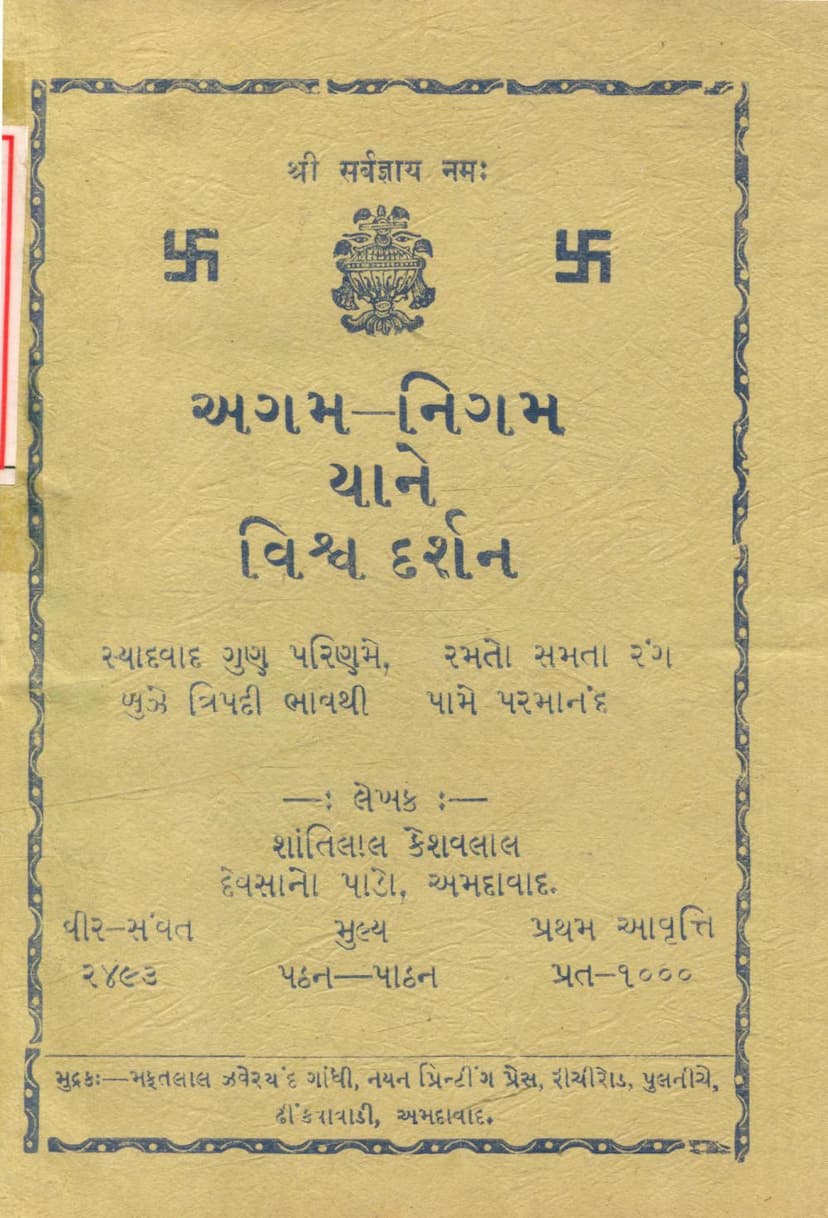Agam Nigam Yane Vishva Darshan
Added to library: September 1, 2025

Summary
Here's a comprehensive summary of the Jain text "Agam Nigam Yane Vishva Darshan" by Shantilal Keshavlal, based on the provided pages:
Title: Agam Nigam Yane Vishva Darshan (Agam Nigam: A Vision of the Universe)
Author: Shantilal Keshavlal
Publisher: Shantilal Keshavlal
Core Theme: The book aims to provide a comprehensive philosophical and spiritual vision of the universe according to Jain principles. It delves into various aspects of Jain philosophy, emphasizing the importance of right understanding, right knowledge, and right conduct for achieving liberation.
Key Concepts and Structure:
The book is structured around exploring the universe and its constituents through the lens of Jain metaphysics, epistemology, and ethics. It utilizes a systematic approach, breaking down complex concepts into manageable sections. The central premise appears to be understanding reality (Vishva Darshan) through the Agam (scriptural knowledge) and Nigam (systematic or inferential knowledge).
Main Sections and Their Content:
-
The Twenty-Seven-Fold Framework of the Universe:
- Nine Tattvas (Realities): The foundation of the universe is presented through the nine fundamental realities of Jainism: Soul (Jiva), Non-soul (Ajiva), Merit (Punya), Demerit (Papa), Influx of Karma (Asrava), Stoppage of Karma (Samvara), Shedding of Karma (Nirjara), Bondage of Karma (Bandha), and Liberation (Moksha). The book likely elaborates on the nature and interrelation of these tattvas.
- Essential Sadhana (Purposes of Spiritual Practice): The text introduces three key aspects of spiritual pursuit: the goal (Sadhya), the means (Sadhak), and the process (Sadhan). This highlights the interconnectedness of aim, effort, and methodology in spiritual progress.
- The Namaskar Mahamantra: The five holy salutations (Namo Arihantanam, Namo Siddhanam, Namo Ayariyanam, Namo Uvajjhayanam, Namo Loye Savva Sahunam) are presented as the supreme mantra for removing sins and achieving auspiciousness, underscoring their spiritual significance.
- The Nine Paths to Purity (Navapada): This section outlines nine steps or stages leading to purity and liberation, likely representing a progressive path of spiritual discipline.
-
Twenty-Seven Aspects of Agam-Nigam Knowledge:
- This section delves into the diverse forms and types of knowledge as understood through the Agam and Nigam perspectives. It suggests a detailed exploration of how scriptural insights and logical reasoning contribute to a complete understanding of reality.
-
Twenty-Seven Paired Subjects (Yugal Vishay):
- The book systematically discusses pairs of contrasting or complementary concepts, offering a nuanced understanding of Jain philosophy. These pairs include:
- Jiva-Ajiva (Soul-Non-soul)
- Punya-Papa (Merit-Demerit)
- Asrava-Samvara (Influx-Stoppage of Karma)
- Vedana-Nirjara (Experiencing-Shedding of Karma)
- Bandha-Moksha (Bondage-Liberation)
- Heeya-Upadeya (To be Abandoned-To be Accepted)
- Sva-Para (Self-Other)
- Dravya-Paryaya (Substance-Mode)
- Karya-Karana (Effect-Cause)
- Karta-Karma (Doer-Deed)
- Dhyana-Dhyeya (Meditation-Object of Meditation)
- Yoga-Upayoga (Activity-Consciousness/Attention)
- Jnana-Kriya (Knowledge-Action)
- Aradhak-Viradhak (One who practices-One who deviates)
- Nishchaya Drishti-Vyavahara Drishti (Ultimate View-Conventional View)
- Utsarga-Apavada (General Rule-Exception)
- Sat-Asat (Real-Unreal)
- Nitya-Anitya (Eternal-Non-eternal)
- Eka-Anek (One-Many)
- Samanya-Vishesha (General-Particular)
- Anadi-Ananta (Without beginning-Without end)
- Siddha-Sansari (Liberated-Worldly)
- Laukika-Lokottara (Worldly-Transcendental)
- Bhuta-Bhavishya (Past-Future)
- Vachya-Vachak (The spoken-The speaker)
- Ekanta-Anekanta (One-sidedness-Multi-sidedness)
- Sukha-Dukha (Happiness-Sorrow)
- The book systematically discusses pairs of contrasting or complementary concepts, offering a nuanced understanding of Jain philosophy. These pairs include:
-
Twenty-Seven Miscellaneous Topics (Prakirnak Vishay):
- This section covers a variety of specific topics, indicating the breadth of the book's exploration. These include discussions on:
- The nature of Pramana (means of valid knowledge) and the Sapta Bhangi (Seven-valued logic).
- The author's perspective on atheists and non-believers.
- The application of Sapta Bhangi to various Tattvas (Jiva, Ajiva, Punya, Papa, etc.).
- The nature of the four Nikshepas (Name, Establishment, Substance, and Mode).
- The concept of Tri-bhangi (three-fold aspect) related to Tirthankaras, and Chau-bhangi (four-fold aspect) related to Devatattva, Gurutatva, and Dharmatattva.
- The concept of Shat-karaka (six case relationships) in different states of consciousness (Bahir-atma, Antar-atma, Param-atma).
- The vows of Sadhus (Maha-vrata) and Shravakas (Anu-vrata).
- This section covers a variety of specific topics, indicating the breadth of the book's exploration. These include discussions on:
Author's Intent and Tone:
The author, Shantilal Keshavlal, expresses a deep reverence for the teachings of the omniscient Tirthankaras and the interpretations of past learned scholars (Gitarth Gurus). He emphasizes the importance of studying and adhering to the established scriptures to avoid "Ut-sutra" (incorrect or distorted teachings) which can lead to spiritual downfall. The preface indicates a concern about the growing influence of materialistic and atheistic viewpoints and aims to provide a clear philosophical foundation for spiritual seekers. The tone is scholarly, devotional, and deeply rooted in Jain tradition.
Overall Message:
"Agam Nigam Yane Vishva Darshan" appears to be a detailed exposition of Jain philosophy, aiming to equip readers with a thorough understanding of the universe, the nature of the soul, the workings of karma, and the path to liberation. It emphasizes the importance of adhering to the teachings of the Tirthankaras and the guidance of qualified gurus for accurate spiritual understanding and practice. The book advocates for a balanced approach, integrating scriptural knowledge with logical reasoning and ethical conduct to achieve the ultimate goal of Moksha.